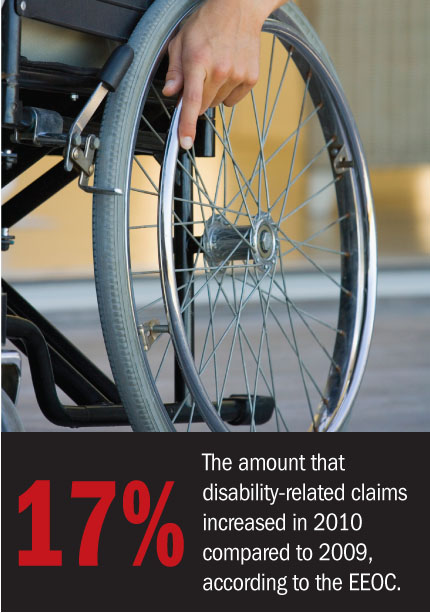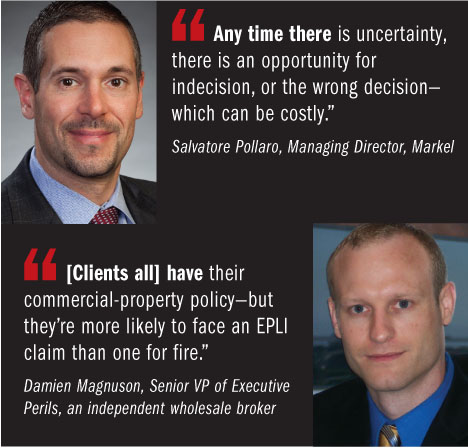 Steps taken by federal officialsto broaden the definition of “disability” is putting pressure onemployers—and insurers are forecasting an increase inemployment-practices liability (EPLI) claims.
Steps taken by federal officialsto broaden the definition of “disability” is putting pressure onemployers—and insurers are forecasting an increase inemployment-practices liability (EPLI) claims.
The Americans with Disabilities Act Amendments Act (ADAAA),which went into effect on Jan. 1, 2009, directed the U.S. EqualEmployment Opportunity Commission (EEOC) to revise its regulations“to restore the intent and protections” of the original act, and toaddress what lawmakers felt was a too-narrow view taken by courtsof the original ADA provisions.
|The EEOC’s final regulations to implement the ADAAA were madeavailable on the Federal Register Web site in March 2011 and wereput into effect just this May.
|INSURANCE IMPLICATIONS
|As a result of the EEOC rulings, which broaden the definition ofdisability to include protections for employees with, for example,cancer, diabetes or epilepsy, Salvatore Pollaro, managing directorfor Markel, is one of many experts who expect to see an increase inthe frequency and severity of ADA-related EPLI claims in 2012.
|“Right now, there is a lot of interpretation going on” aroundthe “difficult-to-decipher” revised regulations, he says. “And anytime there is uncertainty, there is an opportunity for indecision,or the wrong decision—which can be costly.”
|Employers and insurers are “uncertain how the courts willinterpret the law,” adds Damien Magnuson, senior vice president ofExecutive Perils, an independent wholesale broker. “After all,there has not been much consistency in the courts, which is whyamendments to the act were made in the first place.”
|Joni Mason, senior vice president and employment-practicesliability product manager at Chartis Insurance, says the definitionof disability under the law was “significantly expanded” by theADAAA, and she also expects claims numbers to grow as a result.
|That’s a potentially disturbing statement for both insurers andemployers, as disability-related claims already increased 17percent in 2010 compared to 2009—before the revised finalregulations went into effect in May.
| In response to the changes, Masonsays Chartis is training its underwriters to adjust to the expandeddefinitions of disability. Pollaro says Markel’s underwriters aretaking a similar approach as they would with other emerging issues:a careful watch.
In response to the changes, Masonsays Chartis is training its underwriters to adjust to the expandeddefinitions of disability. Pollaro says Markel’s underwriters aretaking a similar approach as they would with other emerging issues:a careful watch.
“You need to stay current without reacting for no reason,” heobserves.
|Melissa Mattioli, vice president of employment-practicesliability at Liberty International Underwriters, says she, too,predicts an uptick in claims, although the insurer hasn’t witnessedthis just yet.
|Numerous blogs from defense-attorney firms point to projectedincreases in ADA-related claims as well. According to one blogwritten by the Southeastern law firm Miller Martin, the ADA may nowbe “so broad that all of us may have disabilities.”
|GETTING THE MESSAGE, GRASPING THE RISKS
|Companies do seem to be getting the message that the rightcoverage is key. Submissions and inquiries around EPLI are up, saysMagnuson of Executive Perils.
|And clients have been asking ADAAA-related questions to get abetter sense of its regulations and the accommodations now requiredby employers, says Tom Hams, managing director and EPLI nationalpractice leader at Aon Risk Solutions.
|Every industry expert interviewed by NU stressed thateducation is key for employers. Ask questions, they say. Do yourresearch. Use EEOC resources. Train managers and HR departments,because one oversight—one seemingly innocent oversight—can lead toa claim.
|“A person with diabetes, for instance. You can’t ask how longthey’ve had it, or how long they’ve been taking medications—even ifit seems to you to be within the regular course of typicalconversation,” Mattioli explains.
|“Then you must provide reasonable accommodations—a place to testblood sugar, a break to take medications and time to rest,” sheadds. “It’s very challenging. There are so many variables.”
|Mason says the focus for employers should not be whether adisability exists, but in engaging in the interactive process anddeciding what steps, if any, are necessary to provide a reasonableaccommodation.
|“At Chartis, we are trying to make sure that we educate themarket so that companies large and small realize thevulnerabilities and don’t turn a blind eye to their risk,” sheadds.
|Currently, many insureds may not understand the risks—especiallysmaller employers without the benefit of risk managers, outsidecounsel and human-resources departments.
|“They may think their general-liability policyoffers coverage, but it’s very limited,” says Magnuson. “It’s bestto discuss the issue with your broker to limit your damage.[Clients all] have their commercial-property policy—but they’remore likely to face an EPLI claim than one for fire.”
|COST-BENEFIT ANALYSIS
|EPLI coverage is not necessarily cheap, and risk managers orother professionals charged with presenting cost-benefit analysescould face corporate resistance. But Magnuson argues the cost consare far outweighed by the policy pluses.
|“It’s cheaper to [purchase the proper risk coverage] than todefend yourself against one of these claims,” he says. “It might bebest to err on the side of caution, especially with this.”
|That opinion was shared by other executives as well. Pollarosays a policy “offers great value” and covers defense and indemnity(but will not cover the cost of physical modifications toaccommodate an employee).
|Adds Mattioli, “It’s still a very competitive market with a lotof capacity. It’s a good time to buy.”
|Pollaro says he has witnessed insureds “doing their best effortsto stay ahead of the law and evolve—not just for the financialresult, but because they really want to do the right things fortheir employees.”
|
Want to continue reading?
Become a Free PropertyCasualty360 Digital Reader
Your access to unlimited PropertyCasualty360 content isn’t changing.
Once you are an ALM digital member, you’ll receive:
- All PropertyCasualty360.com news coverage, best practices, and in-depth analysis.
- Educational webcasts, resources from industry leaders, and informative newsletters.
- Other award-winning websites including BenefitsPRO.com and ThinkAdvisor.com.
Already have an account? Sign In
© 2024 ALM Global, LLC, All Rights Reserved. Request academic re-use from www.copyright.com. All other uses, submit a request to [email protected]. For more information visit Asset & Logo Licensing.








